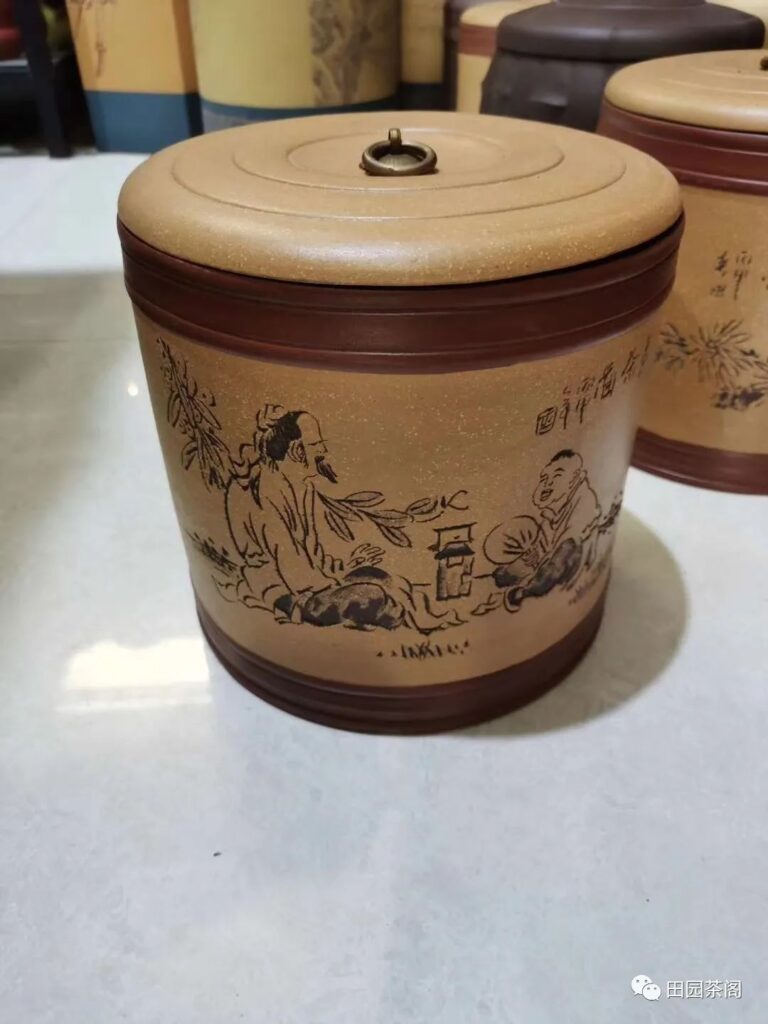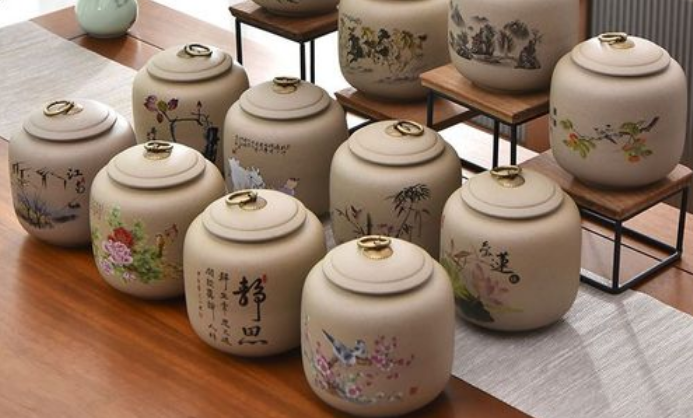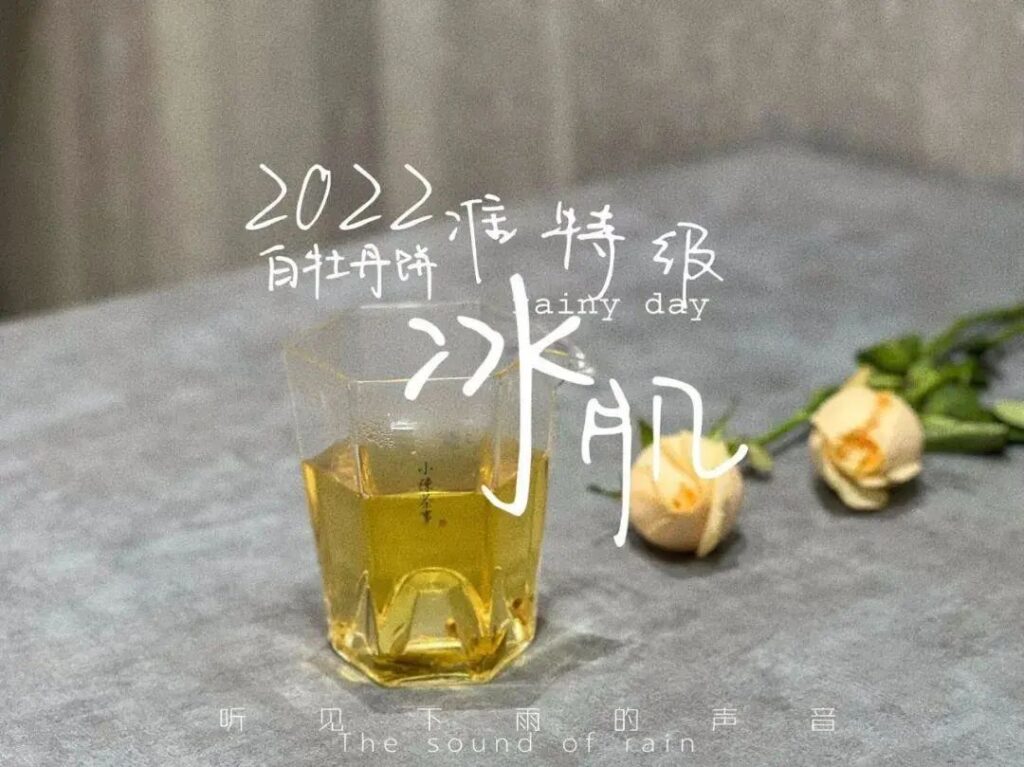# Storage Methods and Durations of Various Teas
## Tieguanyin
### Refrigeration for Preservation
Seal the tea well and put it into a container, then place it in the refrigerator’s refrigeration compartment.
### Preservation in a Sealed Jar
Put quicklime or charcoal at the bottom of an airtight container. The quantity should be about 1/3 of the container. Cover it with a layer of clean paper.
### Storage in Tins
Put the tea in tins made of materials such as bamboo boxes and wooden boxes. Such tins have good light-shielding and moisture-proof properties and are an ideal choice for storing most Tieguanyin teas.
The shelf life of Tieguanyin depends on the degree of fermentation:
1. For lightly fermented fragrant Tieguanyin, the shelf life is 1 – 2 years.
2. For moderately fermented strong-flavor Tieguanyin, the shelf life can reach more than 2 years.
3. Aged Tieguanyin with a certain age can be stored for about ten years.
## Green Tea
### Storage in Plastic or Aluminum Foil Bags
Wrap the tea in soft clean paper in advance, then put it into a food bag. After filling the bag with tea, squeeze out as much air as possible and seal it.
### Storage in Metal Cans
Choose iron cans, stainless steel cans or tin cans with dense texture to store green tea.
### Low-temperature Preservation Method
Put the green tea into a food packaging bag with high density, high pressure, thickness, good strength and no peculiar smell. Keep the storage environment of green tea below 5 degrees Celsius, that is, use a cold storage or freezer to store green tea. (It is recommended to use this method if you want to maintain the freshness of the tea.)
Green tea has a certain shelf life. Usually, its shelf life is about 1 – 2 years. For some well-sealed packages, such as canned green tea, the shelf life can reach about 3 years, which is mainly related to factors such as the surrounding temperature, light and humidity. If properly stored, the storage time will be slightly longer. Since green tea is an unfermented tea category, if the tea deteriorates, it cannot be brewed and drunk. Generally, after opening the package, it is best to finish drinking it within about half a year. If the color of the tea soup gradually turns red or brown, it means the nature of the tea has changed and it is not suitable for drinking anymore.
## Black Tea
### Storage in Containers
Before storing in a container, check whether the lid is airtight and does not leak. Put the dry tea into the can, filling it up tightly. This is only suitable for short-term storage.
### Storage in Earthenware Pots
Use a dry earthenware pot without peculiar smell. Check whether it is airtight. Wrap the tea in kraft paper and place it around the pot. Then put a small lime bag in the middle and then put more tea. Fill it up and tighten the lid. The lime bag can be replaced every two months. This method is more suitable for long-term storage.
Storing black tea requires relatively high environmental conditions. The best storage environment is dry, at room temperature and away from light.
The shelf life of black tea is generally one to two years, with the best taste achieved within three months of purchase. It typically cannot be stored for more than three years, as improper storage can lead to spoilage. When drinking black tea, do not pursue age; coarsely stored black tea for three years will not have the flavor and aroma of fresh tea from the same year. Additionally, prolonged storage can lead to changes in taste and spoilage due to improper storage. The rich substances in tea leaves will gradually dissipate, resulting in a lack of aroma and a thin, unsweet taste, even giving a watery flavor when consumed.
1) Flower tea storage: Sealed bag preservation – Pack the flower tea and seal the bag tightly. After sealing, store it in a cool, dry, ambient temperature, and light-free place. 2) Cold storage – Pack the flower tea in an aluminum foil bag, seal the bag, and then place it in an iron can. Close the lid and store it in the refrigerator. It is recommended to store it at a temperature of 0-5 degrees Celsius, but it is important to note that different types of dried flower tea should not be stored together as they can absorb each other’s fragrances, leading to a mix of flavors in the brewed tea. Flower tea is best enjoyed within three months to maintain its fresh and refreshing fragrance. The storage time for flower tea should not exceed one year.
1) Yellow tea storage: Sealed bags or aluminum foil bags – Completely seal the bag and then place it in an iron can. Close the lid and store it in the refrigerator, while also preventing odors and moisture. The temperature should be kept around 0-5 degrees Celsius. Yellow tea can be stored for about 18 months in low temperatures and about 6 months at room temperature. Be mindful that tea should be kept separate from other foods to prevent the absorption of other odors, which can alter the taste or cause spoilage. Also, pay attention to the moisture in the refrigerator; if the moisture is too high, it is not suitable for long-term storage.
1) White tea storage: The first choice for storing white tea is to select a cool and dry place, avoiding direct sunlight. Also, avoid ‘east shine, west exposure,’ meaning do not store white tea in rooms facing east or west. The storage environment should be odorless, scentless, and non-toxic. 2) Ambient temperature storage – The ideal temperature for storing white tea is between 4-25 degrees Celsius.
It can be stored at room temperature without refrigeration, sealed. There is a saying about white tea, ‘one year as tea, three years as medicine, seven years as treasure.’ White tea follows ancient methods and has high requirements, making it suitable for long-term storage. Properly stored white tea can continue to ferment, extending its freshness, and during the storage process, it will continue to ferment, making its aroma more rich and its taste more mellow.Pu’er tea, a legend that ‘grows more fragrant with age,’ requires a distinction in storage environment. If the tea you purchase is already pressed into cakes, bricks, tuos, etc., and is in bundles or cases, then store it in its original packaging, such as on a bookshelf in a study. Of course, having a separate tea room is the best option.
You can prepare a dehumidifier, a hygrometer, etc.
1. If it is a single cake or the outer bamboo shell has been removed, it is best to put it in a sand jar to keep it in a slightly breathable state. Do not use a porcelain jar. Loose tea should not be stored in a sealed plastic bag.
2. If you buy whole stacks or whole pieces of finished Pu-erh tea, which usually come with cartons, bamboo shells, cotton paper, etc., they can be directly stored on the shelves in the tea room.
3. For Pu-erh tea to be consumed within 1 – 2 months in the short term or to be ‘awakened’ (dry awakening usually takes about 1 month), it can be placed in containers such as purple clay pots, earthenware urns or earthenware jars. Place the tea cake in a storage container (the container should be odorless, clean and hygienic). It should be noted especially that in areas with high temperature and high humidity, more attention should be paid to observing the indoor environment when storing Pu-erh tea.
In such weather, the tea is prone to mildew. Never place the tea jar directly on the ground. At least place the tea jar more than 20 cm above the ground. Try not to store it on the first floor or the top floor either. Since the temperature for storing Pu-erh tea should not be too high or too low, too high a temperature will accelerate the fermentation of the tea and make it sour. The storage temperature should be based on the local environment and there is no need to deliberately create a temperature artificially. Storing Pu-erh tea requires an appropriate humidity. The humidity should be controlled accordingly. The annual average humidity should not be higher than 65% – 75%. The environmental temperature for storing tea should be between 20 – 30 degrees Celsius and should not exceed 35 degrees. Too high or too low a temperature is not conducive to the aging of Pu-erh tea. At the same time, avoid the influence of air conditioners, direct light, etc. on the quality of Pu-erh tea. When storing, it is recommended to store raw tea and ripe tea, new tea and old tea separately to avoid mutual influence. At the same time, when storing tea, it should be kept away from the ground and the wall, and inspected regularly. Pu-erh tea does not have a clear shelf life and can be stored for a long time, and the older it gets, the better. Commonly seen Pu-erh tea is 10 – 20 years old.1. Raw Pu-erh tea ferments naturally and oxidizes slowly. It takes 10 – 15 years to reach the peak of taste.
2. Ripe tea undergoes artificial fermentation in a pile, and the process is accelerated. Generally, it will have a good taste after being stored for 3 – 5 years. The above time is not the storage limit of Pu-erh tea, but the years with good tea flavor.
How to judge whether Pu-erh tea has deteriorated or expired:
1. You can smell the tea to see if there is any strange smell. Normal tea has a fresh fragrance. Look at the color of the tea soup. The normal tea soup is clear and bright. Taste the tea soup to see if it is no longer fresh, strong and refreshing. A normal tea soup tastes sweet, warm, smooth, mellow, clear, sweet, and lingering when tasted.
2. If clear white dots appear on Pu-erh tea, or white fluff grows, or white foam or green fluff appears, unevenly and in different sizes distributed on Pu-erh tea, it indicates that the Pu-erh tea has become moldy and cannot be consumed continuously to avoid harm to the human body.
Storing tea preserves the weight and thickness of time. What lies deep within is the flavor of time, a collection of one’s own memories.
As time passes, new tea evolves from astringency to mellowness, from intensity to gentleness. It also completes the mellowing and sublimation of life, with everything approaching perfection. Tea ages with the tea lover. The joy of indulging in tea lies precisely in this.


